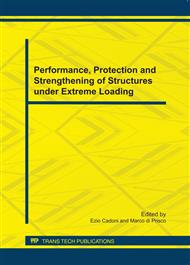p.497
p.503
p.509
p.515
p.521
p.527
p.533
p.539
p.545
Experimental Study on the Influence of Boundary Condition on the Behavioral Characteristics of CFT Square Columns under Constant Axial Load upon a Fire
Abstract:
The temperature of the steel tube of a CFT column rises rapidly upon a fire causing the deterioration of its strength, while the concrete inside of the tube having large heat capacity provides fire-resistance performance. In order to employ CFT columns as fire-resistant structure, it is necessary to conduct studies on the factors exerting influence on structural capacities and the influence associated with each condition. Concrete’s compressive strength, cross-section size, axial load ratio and boundary condition are the major factors which are influential in fire-resistance performance. In particular, boundary condition between columns and beams is one of the major factors which decide fire-resistance performance because it exerts influence on load carrying capacity. The result of the test conducted in this study showed that fire-resistance time of 106 minutes was secured in the specimens with clamped ends and that of 89 minutes in those with pinned ends when cross-section size was 360mm by 360mm. In the specimens with cross-section size of 280 mm × 280mm, fire-resistance time of 113 minutes was secured under the condition of clamped ends and that of 78 minutes was secured under the condition of pinned ends.
Info:
Periodical:
Pages:
521-526
Citation:
Online since:
July 2011
Authors:
Keywords:
Price:
Сopyright:
© 2011 Trans Tech Publications Ltd. All Rights Reserved
Share:
Citation:


